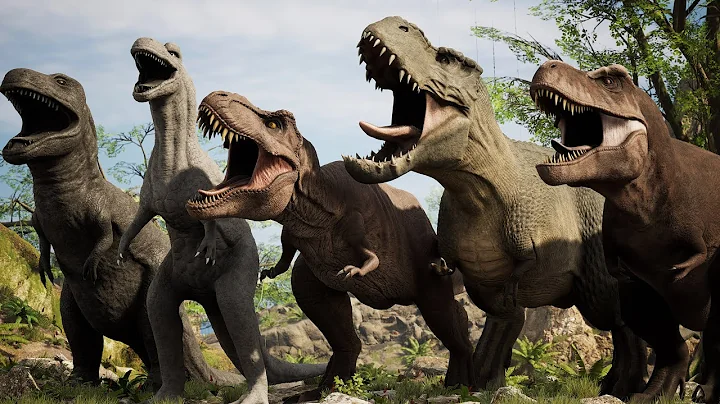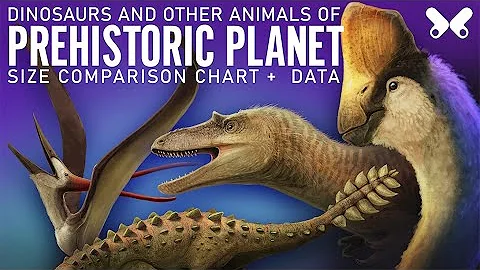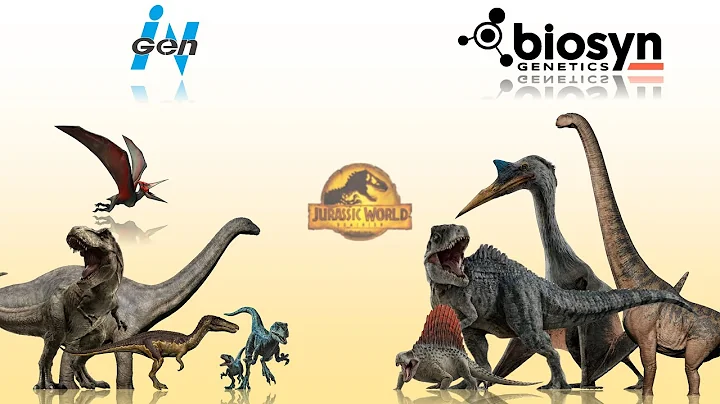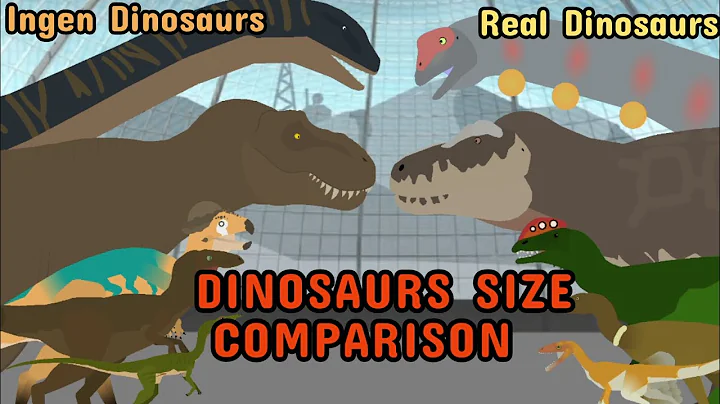Text | "China Science News" reporter Hu Minqi
On the screen in early summer, dinosaurs dominate the screen!
However, the reputations of the movie series "Jurassic World 3" and the paleontology documentary "Prehistoric Planet" produced by the BBC Natural History Department are in sharp contrast.
The shocking special effects of the former movie are difficult to win over the audience. What the audience wants this time is "realism".
"Prehistoric Planet" combines CGI (computer graphics technology) animals with realistic natural geographical environments to create spectacular visual effects. Moreover, the production team also stated that everything about the dinosaurs shown in the documentary is based on the latest scientific discoveries and opinions and is not fabricated out of thin air.
For scientific restoration, they specially found experts in multiple fields such as paleontologists, botanists, and scientific illustrators, just to present the ecological world closer to 66 million years ago.
How scientific and artistic is this "resurrection drama" of prehistoric creatures?

"Prehistoric Planet" poster
Morphological restoration
Scientific: ★★★★☆
Artistic: ★★★★★
All paleontological restoration starts from fossil specimens.
Wang Yu, a paleontology restoration designer at the Institute of Vertebrate Paleontology and Paleoanthropology, Chinese Academy of Sciences (hereinafter referred to as the Institute of Vertebrate Paleontology), said that they will use CT (computed tomography) or three-dimensional scanner to scan fossil bone specimens to generate three-dimensional data. , thereby determining the three-dimensional shape of the skeleton, and then attaching soft tissues, including muscles, fat, and skin, to finally form a flesh-and-blood animal image.
"But because most of the excavated fossil materials are incomplete, we must deduce what the missing parts may look like from living close relatives based on the phylogenetic relationship of the animal." Wang Yu said, this It also means that paleontological restoration is not a completely true representation.
As more fossil evidence and new research results emerge, the details of the recovery of the same ancient creature are constantly changing and getting closer to reality. In his view, a restored image represents the summary of a stage of scientific cognition.
A large number of dinosaurs appearing in "Prehistoric Planet" are all feathered, but in the famous documentary "Walking with Dinosaurs" also produced by BBC in 1999, the dinosaurs were cold-blooded reptiles covered in scales and armor.
This is because more than 20 years ago, many dinosaur fossils with traces of feathers were gradually unearthed from the Jehol Biota in western Liaoning, my country. They not only rewrote the history of the origin of birds, but also broke through people's inherent understanding of the appearance characteristics of dinosaurs.
For another example, new research shows that some carnivorous dinosaurs, including Tyrannosaurus rex , had "lips". When the mouth was closed, the teeth were covered, and the nostrils were located closer to the snout.
He also mentioned that there is a detail throughout the film that deserves attention, and that is the individual differences of different creatures, which are reflected in the differences between males and females and age differences. In the past, adults and juveniles were even considered two different species.
Wang Yu believes that the documentary has done an excellent job in restoring these details of the dinosaur image based on the description and viewpoints of existing science.
However, not all the morphological characteristics displayed in the documentary have scientific basis, and some imaginations are simply "astonishing".
For example, a group of fearless dragons appeared in the desert. It is a large new type of sauropod dinosaur, with a huge body and a slender neck. The adult body can reach 25 meters tall. However, in the documentary, the neck of the Dreadnoughtosaurus is extremely unique, because there are two rows of telescopic sacs neatly attached to it. They can bulge out one by one from top to bottom, and then retract from bottom to top, and these telescopic sacs Existing solely for mating display.

Dauntless Dragon
"There is fossil evidence that some large sauropod dinosaurs have cavities in their cervical vertebrae, which served to reduce weight and possibly accommodate air chambers to assist breathing."But Wang Yu bluntly said that the airbag structure similar to the courtship display of living birds in the film should be an element of science fiction.
Behavioral Restoration
Scientificity: ★★★☆☆
Artistry: ★★★ ★★
In a dense forest, there is a clean open space. The 2-ton, 3.6-meter-tall Carnotaurus is cleaning its "stage", leaving it alone in the dense forest. It echoed.
At this time, a larger female Oxaurus appeared in front of it. The latter turned around cutely, raised its tail, and suddenly opened a pair of useless, mini. The "little short hand" uses the ball joints in its arms to swing flexibly. It also moves its body with clumsy steps.
In the documentary, a mating performance from a large dinosaur is both inconsistent and funny. . Unfortunately, the female Taurus only sniffed it and turned away.
In addition to the restoration of the shape, the restoration of the dinosaur's behavior is the absolute highlight of this documentary, and it is also the part that best stimulates scientific imagination.
Wang Yu said. The biggest obstacle to restoring the behavior of paleontological creatures is that most of them do not have fossil basis. It is usually necessary to compare the present with the past and refer to the behavioral patterns of a large number of living creatures. Moreover, the production team also obtained the sounds of millions of animals from the BBC Natural History Department. Materials, creating a set of prehistoric sounds based on phylogenetic relationships.
In his opinion, some cross-species behavior borrowing and transplantation are a very pioneering restoration attempt. The audience asked "Is it true?" I feel that many of the action scenes are familiar.
The first scene of the film broke many people's original perceptions - a huge Tyrannosaurus rex was actually swimming in the water, with a group of Tyrannosaurus rex babies beside him.
Can they swim? Scientists have no definite conclusion on this question, but fossil evidence shows that there are cavities in the bones of large theropod dinosaurs , so they were not as heavy as they appear.

"Prehistoric Planet". Tyrannosaurus rex
Moreover, there are footprint fossils left on the ancient river bed, showing toe scratches left by large theropod dinosaurs when they floated in the water, which may be evidence that this type of dinosaur had swimming behavior.
Wang Yu said that we The familiar elephants, emu , have been recorded with images of floating. In terms of efficiency and posture, they are capable but not good at it. The same should be true for tyrannosaurs
Plesiosaurus is a very famous type. A marine reptile, the documentary shows a very strange behavior of it - swallowing pebbles on the seabed.
"There is fossil evidence of large sauropod dinosaurs swallowing stones. Researchers call them gastroliths, which are mainly used to grind food." Wang Yu said that it can also be seen in living reptiles , and their teeth provide Without a very sufficient grinding function, eating mainly depends on swallowing, which puts a heavy burden on the digestive system. The stones can help grind food, and the surface of these stones will become smoother afterward.
"And its other function may be a ballast stone." Wang Yu said that scientists have found that after crocodiles swallow stones, they can sink longer, helping to maintain a better sinking and floating balance.
If this behavior of the plesiosaur is based on scientific speculation, then the next scene is more like a romantic imagination.
The plesiosaur stretched its huge neck straight out of the water in a courtship display. Then, the two plesiosaurs who looked at each other intertwined each other's necks, accompanied by the light and shadow of the seabed and beautiful music, full of moving colors.
Many birds, such as swans, extend their necks upward to sing or intertwine their necks to form a heart shape when courting. But in Wang Yu’s view, for such an ancient reptile, this is more like an artistic treatment that serves the narrative and emotional transmission of the documentary.
The Barbary pterosaur had a wingspan of 5 meters, and it also had a signature huge head crest. Large males will choose an area to perform courtship displays.But it’s not just the heavyweights who win.

Barbary pterosaur
can't beat it, it has just the right IQ. In the documentary, a male Barbary pterosaur does not have a huge crest and looks the same as a female. Therefore, it simply hides among the female group, hoping to "get the moon first by getting closer to the water." But this is a dangerous game because sometimes it is mistaken for a male and receives a courtship message. So it quickly ran away and got down to business in finding a partner, and it really succeeded.
In summer, warm air rises and is attached to charged particles, creating lightning storms and triggering forest fires. Some plants are roasted into "tinder." Most animals will run away, but for some it's a chance.
The 1.8-meter-long Troodon is a relatively small member of the theropod dinosaurs, but in terms of brain volume ratio, it is considered to be the most intelligent dinosaur. In the documentary, it uses natural fire to start a new fire, thereby forcing the prey there to escape from their hiding places and become its meal.
There is no direct evidence whether these cunning behaviors actually exist in ancient creatures, but behaviors such as "men dressing up as women" and "arsonists" can indeed find prototype examples in living creatures, such as some birds.
Wang Yu believes that the settings of these plots have greatly increased people's understanding of the diversity of ancient and modern biological behaviors, and added to the drama and excitement of the documentary narrative on a reasonable basis. They have a very typical experimental spirit and are an important part of the scientific restoration of paleontology. kind of extension.
Ecological restoration
Scientificity: ★★★☆☆
Artistic quality: ★★★★★
The production process of "Prehistoric Planet" was very long, more than three and a half years in total. A lot of this was due to the producers' decision to combine computer-generated creatures with real-world natural backgrounds to create even more spectacular visuals. The team was sent around the world to capture footage, from Iceland to Namibia, looking for backgrounds "similar" to the world 66 million years ago.
Live shooting naturally has the advantage of being "real" and can create a real "nature documentary" quality.
However, according to Wang Xiaolin , a researcher at the Institute of Vertebrate Paleontology, this is just a good wish of the production team. The "reality" of the natural environment has caused one of the most unignorable bugs in scientific restoration - the ecological environment during the dinosaur period, and Our current natural environment is very different.
Wang Xiaolin said that whether it was the Jurassic or the Cretaceous, the most common living environment for dinosaurs was relatively warm and humid, because most of them were cold-blooded animals and relied on external temperatures to increase their body temperature to enhance their mobility. Moreover, the large sauropod dinosaurs that appear in large numbers in the documentary are herbivorous and social animals that rely on a large number of plants to survive.
"However, they frequently appear in deserts and frozen worlds. Although their fossils were found in the Gobi desert or the polar regions, it does not mean that the world they lived in was that scene."
Wang Xiaolin also mentioned that although the documentary River and forest environments also appear, but the plant framework there is seriously wrong. "When dinosaurs lived, gymnosperms mainly grew, such as ginkgo, pine, cypress, fir, cycad, and some fungi. But in the documentary, it is angiosperms that occupy the main ecological niche."
The production team once said that they used paleoclimate models to provide data sets to provide the most scientific description of the environment at that time, but the results did not seem to be ideal.
In Wang Xiaolin's view, the ecological environment is often the part where details are easily missed in paleontological restoration.
What impressed him deeply was that in 2008, he and his collaborators discovered one of the smallest pterosaurs in the Cretaceous - The Forest Pterosaur , with a wingspan of only 25 centimeters. They perch on tree branches and feed on insects. So, in the carefully painted restoration painting, the reclusive forest pterosaur holds a brightly colored small ladybug in its mouth.Unexpectedly, a scientist who studies insects saw through the problem at a glance. Ladybugs had not yet evolved during the Cretaceous era.
This ecological restoration map of a reclusive forest pterosaur still hangs in a prominent position in Wang Xiaolin's office, reminding him all the time.
(Photo source for this article: Apple TV+)





















